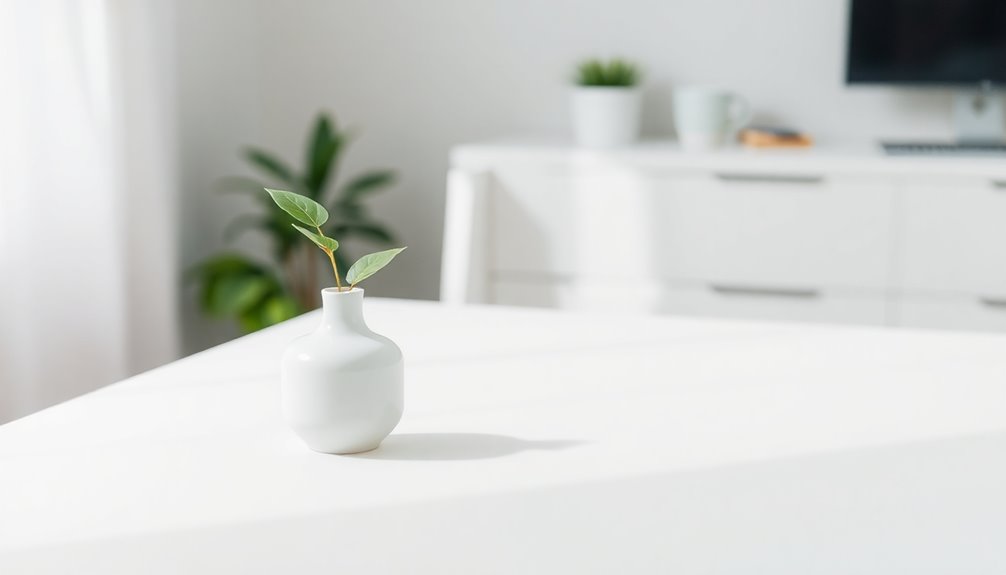To use white space effectively in your design projects, balance micro and macro white space to improve readability and create a polished look. Use macro white space to provide breathing room around key elements and adjust micro white space for ideal letter and line spacing. Limit the number of design elements to avoid clutter. Implement consistent spacing and proper text formatting. Keep exploring to uncover more tips for enhancing your designs with white space.
Key Takeaways
- Utilize macro white space around key layout elements to create breathing room and enhance overall visual clarity.
- Adjust micro white space for letter and line spacing to improve text legibility and reading speed.
- Apply the law of proximity to group related items, fostering a more organized and intuitive design.
- Maintain a balance of 30-40% active white space and 60-70% passive white space to enhance user engagement.
- Use design tools like Canva and Adobe XD to effectively maximize white space in your projects.
Understanding White Space in Design

White space, often referred to as negative space, is an essential element in design that you shouldn't overlook. It surrounds your design elements, creating balance and improving how your audience processes visual information.
You can classify white space into micro white space, which includes small gaps between letters and lines, and macro white space, which refers to larger areas around key layout elements.
By effectively using white space, you enhance text readability and legibility, separating blocks of content for easier comprehension. Additionally, it guides user attention, emphasizing important elements and promoting a clear visual hierarchy.
Don't view white space as wasted space; instead, appreciate its role in creating a polished, professional appearance and supporting cohesive branding efforts. Furthermore, incorporating effective networking strategies can enhance your design's overall impact and reach.
The Importance of White Space in Design

White space plays an essential role in enhancing readability and clarity in your designs. By strategically using it, you can create a visual hierarchy that guides users' attention to important elements. This not only makes your content easier to digest but also elevates the overall user experience. Additionally, effective use of color palette can further enhance the impact of white space in your design projects.
Enhancing Readability and Clarity
Effective design hinges on the strategic use of space, which plays an essential role in enhancing readability and clarity. By incorporating adequate white space in your design layout, you can boost text readability by up to 20%. This allows for natural reading pauses and considerably reduces visual clutter.
Micro white space, like the gaps between letters and lines, enhances legibility and prevents a cluttered look. Additionally, proper white space between content blocks aids in organizing information, making it easier for viewers to process and understand your material. Furthermore, utilizing human-centered methodologies can help ensure that your design effectively meets the needs of your audience, thereby enhancing overall user experience.
Promoting Visual Hierarchy
In any design, the strategic use of white space plays a pivotal role in promoting visual hierarchy. By incorporating white space effectively, you can differentiate primary design elements from secondary ones, guiding your viewer's attention where it's needed most.
Ample white space around important content enhances focus, creating a clear path for users and improving overall user experience. This approach can boost text readability by up to 20%, allowing users to process information efficiently and reducing cognitive overload.
Additionally, strategic placement of white space draws attention to calls-to-action and critical messages, ensuring they stand out. By utilizing both micro and macro white space, you create a balanced layout that logically organizes content, reinforcing the relationship between elements and enhancing visual appeal. Moreover, just as air purifiers improve air quality, effective use of white space can significantly enhance the clarity and effectiveness of your design.
Types of White Space: Micro and Macro

When you're designing, understanding the two types of white space—micro and macro—can transform your work. Micro white space focuses on the small gaps between elements, enhancing readability, while macro white space gives your layout breathing room. Balancing both is key to creating a visually appealing and organized design. Additionally, leveraging user experience can significantly enhance the effectiveness of your design by ensuring that the layout meets the needs of your audience.
Defining Micro White Space
Micro white space plays a pivotal role in design, as it encompasses the small gaps between individual elements like letters, lines of text, and graphic components. Proper use of micro white space enhances legibility and reading speed, boosting comprehension by up to 20%. It helps maintain visual balance and contributes to the overall organization of your design projects. Though often unnoticed, effective micro white space creates a polished look that enhances user experience by making text approachable and easy to digest. Additionally, continuous learning in design principles can further improve the application of micro white space.
| Aspect | Impact on Design |
|---|---|
| Legibility | Increases clarity |
| Visual Balance | Creates harmony |
| Overall Organization | Improves flow |
| Reading Speed | Accelerates comprehension |
| User Experience | Enhances engagement |
Understanding Macro White Space
Macro white space is essential in design, serving as the larger canvas that frames your content. By incorporating ample macro white space, you enhance visual clarity and guide users' focus toward critical elements.
This effective use of space creates breathing room, improving readability and reducing cognitive overload. You can achieve better content organization by dividing sections with larger areas of empty space, making information more digestible.
Often associated with minimalist design, macro white space conveys luxury and sophistication while promoting a polished, professional appearance. Additionally, using cozy spaces in your design can create inviting environments that cater to both families and seniors, enhancing overall well-being.
Balancing Both Types
Achieving harmony between micro and macro white space is essential for creating an effective design. Balancing these two types enhances user experience and establishes a clear visual hierarchy. Micro whitespace improves legibility through spacing between letters and lines, while macro whitespace organizes major design elements, as seen on sites like Google.com.
| Type of Whitespace | Effective Use | Impact on Design Elements |
|---|---|---|
| Micro Whitespace | Enhances text legibility | Improves reading comfort |
| Macro Whitespace | Creates calmness and structure | Prevents clutter |
| Balance | Guides the eye and highlights key elements | Encourages user engagement |
Continuously adjust this balance based on user feedback to maintain an inviting interface that resonates with your audience. Additionally, understanding the importance of self-care practices can greatly influence your design process, as a clear mind helps in making effective design decisions.
Strategies for Applying White Space in Your Designs

When you're designing, incorporating white space isn't just about making things look nice; it's essential for creating an effective layout.
Start by utilizing macro white space to provide breathing room around major elements, enhancing visual hierarchy and guiding user focus.
Don't overlook micro white space; adjusting letter and line spacing can boost readability by up to 20%.
Use the law of proximity to group related items closely while ensuring sufficient white space differentiates distinct areas for better organization.
Regularly evaluate your design to prevent clutter, maintaining a clean look that promotes smooth navigation.
Finally, keep consistency in your spacing to reinforce visual hierarchy and enhance overall clarity, making your design cohesive and inviting. Additionally, studies show that sound therapy can reduce anxiety and depression symptoms, which can be beneficial in creating a calming design environment.
Balancing Active and Passive White Space

In design, the balance between active and passive white space plays an essential role in guiding user attention. Active white space directs focus to key design elements, while passive white space enhances overall readability and aesthetics. Striking the right balance helps prevent cognitive overload and improves user experience. Additionally, incorporating smart home technology can further enhance user interaction by providing intuitive and responsive design elements.
| Type of White Space | Purpose | Recommended Ratio |
|---|---|---|
| Active | Directs attention to elements | 30-40% |
| Passive | Enhances readability | 60-70% |
| Total Space | Fosters visual hierarchy | – |
Best Practices for Effective White Space Implementation

Effective white space implementation is essential for creating visually appealing and user-friendly designs.
The strategic use of white space is crucial for enhancing visual appeal and user experience in design.
To optimize the importance of white space in your visual design, consider these best practices:
- Maintain consistent spacing between graphic elements to reinforce visual hierarchy.
- Limit the number of design elements on a page to prevent clutter and enhance user engagement.
- Use macro white space strategically around major layout components to create breathing room.
- Implement proper text formatting with adequate margins and line spacing to boost legibility.
Tools and Resources for Maximizing White Space

Maximizing white space in your designs can be effortless with the right tools and resources at your disposal. Here's a quick comparison of some popular design platforms that help you optimize white space for better layouts and content organization:
| Tool | Key Features |
|---|---|
| Venngage | Offers templates that enhance visual appeal |
| Canva | User-friendly tools for easy manipulation |
| Visme | Focuses on strategic white space usage |
| Adobe XD | Evaluates spacing and alignment |
| Figma | Enables real-time collaboration |
Analyzing Effective White Space Design Examples

White space is a powerful design element that can transform the user experience by guiding attention and enhancing clarity.
White space is essential in design, shaping user experience by directing focus and improving clarity.
Analyzing effective examples can show you the importance of white space in graphic design and website design:
- Perform.fm uses ample white space to emphasize images and headlines, boosting visual focus.
- Clément Balavoine's site employs exaggerated empty spaces for a striking macro aesthetic.
- Canvas balances macro and micro white space, creating an artistic grid layout for easy navigation.
- Twigs Paper leverages white space in its e-commerce site, delivering a calming shopping experience.
These examples illustrate how the use of white space can enhance clarity, making it an essential strategy in your design projects.
Enhancing User Experience Through White Space

While you might underestimate the impact of white space, it plays an essential role in enhancing user experience across various designs. An effective use of white space improves legibility, boosting comprehension by up to 20%.
By reducing cognitive overload, you empower users to navigate content more intuitively. Strategically placing white space around key elements draws attention to specific areas, guiding user focus and interaction.
A balanced approach with micro and macro white space fosters harmony and unity in your overall design, creating a polished look that enhances satisfaction.
Don't forget to continuously evaluate and adjust your white space based on user feedback, ensuring your layout remains user-friendly and engaging.
Embrace white space to elevate your design and user experience!
Frequently Asked Questions
How to Effectively Use White Space in Graphic Design?
To effectively use white space in graphic design, you should focus on creating balance and clarity.
Start by ensuring proper spacing between lines and paragraphs to enhance legibility. Use micro white space to prevent clutter and improve overall design harmony.
Strategically place macro white space around key elements to guide attention and emphasize important information.
Consistent spacing between grouped items will reinforce visual hierarchy, making navigation intuitive and elevating your design's perceived value.
What Are the 12 Principles of Design White Space?
When exploring the 12 principles of design white space, you'll find that balance, clarity, emphasis, consistency, and alignment stand out.
Each principle plays a crucial role in creating visually appealing and effective layouts. You're encouraged to use white space to enhance organization and guide the viewer's eye.
What Is the Efficient Use of Whitespace?
Think of whitespace as the breathing room in a crowded room.
When you efficiently use it, you create a comfortable space that invites people in rather than pushing them away.
By strategically spacing text and elements, you enhance readability and guide your audience's focus.
It's like clearing clutter from a desk; everything feels more organized and easier to navigate.
What Is the Function of White Space in Effective Document Design?
White space plays an essential role in effective document design. It enhances readability by allowing your text to breathe, making it easier for readers to comprehend information.
By organizing content and visually separating sections, you guide the reader's eye smoothly through the document. Additionally, strategic use of white space emphasizes key elements, minimizing distractions.
Conclusion
Incorporating white space into your design isn't just about leaving areas blank; it's like giving your content room to breathe. By understanding its importance and applying it thoughtfully, you'll create designs that not only look great but also enhance user experience. Remember, a little white space can go a long way in guiding your audience's attention and making your message shine. So, embrace the empty spaces—they're your design's best-kept secret!









